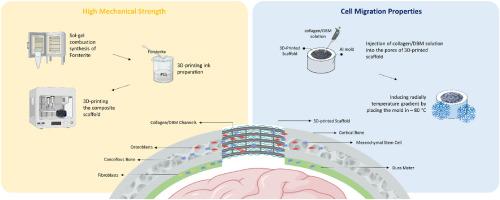胶原-脱矿骨基质3d打印PCL/forsterite支架用于颅骨再生的体外评价
Q1 Computer Science
引用次数: 0
摘要
由于高机械强度、可控降解和支持细胞迁移和增殖,开发适合颅骨成形术应用的支架仍然具有挑战性。尽管钛植入物、同种异体骨移植物、羟基磷灰石和聚甲基丙烯酸甲酯等传统材料被广泛使用,但它们的局限性阻碍了它们的有效性。在单一支架中实现强大的机械性能和良好的生物特性仍然是一个重大挑战。在这项研究中,我们介绍了一种新的制造方法,将3D打印和定向冷冻铸造相结合,以创建具有增强结构和生物特性的混合支架。聚己内酯(PCL)和forsterite (FO)的复合材料被3d打印以提供机械稳定性。同时,将胶原蛋白和脱矿骨基质(DBM)冻铸入孔内,形成径向排列的微通道。这种设计通过模仿天然的细胞外基质结构来增强生物特性和促进细胞迁移。我们的研究结果表明,在PCL中加入10%的forsterite可以将杨氏模量提高到100mpa,在磷酸盐缓冲盐水(PBS)中浸泡一个月后,杨氏模量降低了12%。径向导向的胶原- dbm网络支持细胞增殖增加2.4倍。此外,体外细胞迁移实验表明,排列支架与随机支架相比,细胞浸润增强。结合定向微观结构、离子释放的化学线索和DBM颗粒,以及机械坚固的平台,为骨再生和颅骨成形术应用提供了一种有前途的策略。本文章由计算机程序翻译,如有差异,请以英文原文为准。

In vitro evaluation of 3D-printed PCL/forsterite scaffolds with aligned collagen and demineralized bone matrix for cranial bone regeneration
Developing an appropriate scaffold for cranioplasty applications remains challenging due to the high mechanical strength, controlled degradation, and support for cell migration and proliferation. Despite their common use, traditional materials such as titanium implants, bone allografts, hydroxyapatite, and poly methyl methacrylate have limitations that hinder their effectiveness. Achieving both robust mechanical performance and favorable biological properties in a single scaffold remains a significant challenge. In this study, we introduce a novel fabrication approach that combines 3D printing and directional freeze-casting to create a hybrid scaffold with enhanced structural and biological properties. A composite of polycaprolactone (PCL) and forsterite (FO) was 3D-printed to provide mechanical stability. Meanwhile, collagen and demineralized bone matrix (DBM) were freeze-cast into the pores to form radially aligned microchannels. This design enhances the biological properties and promotes cell migration by mimicking the native extracellular matrix architecture. Our results showed that adding 10 % forsterite to PCL increased the Young's modulus to 100 MPa, with 12 % degradation after one month of immersion in phosphate-buffered saline (PBS). The radially oriented collagen-DBM network supported a 2.4-fold increase in cell proliferation. Furthermore, the in vitro cell migration assay demonstrated enhanced cellular infiltration in aligned versus randomly structured scaffolds. Integrating a directional microstructure, chemical cues from ion release and DBM particles, along with a mechanically robust platform, offers a promising strategy for bone regeneration and cranioplasty applications.
求助全文
通过发布文献求助,成功后即可免费获取论文全文。
去求助
来源期刊

Bioprinting
Computer Science-Computer Science Applications
CiteScore
11.50
自引率
0.00%
发文量
72
审稿时长
68 days
期刊介绍:
Bioprinting is a broad-spectrum, multidisciplinary journal that covers all aspects of 3D fabrication technology involving biological tissues, organs and cells for medical and biotechnology applications. Topics covered include nanomaterials, biomaterials, scaffolds, 3D printing technology, imaging and CAD/CAM software and hardware, post-printing bioreactor maturation, cell and biological factor patterning, biofabrication, tissue engineering and other applications of 3D bioprinting technology. Bioprinting publishes research reports describing novel results with high clinical significance in all areas of 3D bioprinting research. Bioprinting issues contain a wide variety of review and analysis articles covering topics relevant to 3D bioprinting ranging from basic biological, material and technical advances to pre-clinical and clinical applications of 3D bioprinting.
 求助内容:
求助内容: 应助结果提醒方式:
应助结果提醒方式:


